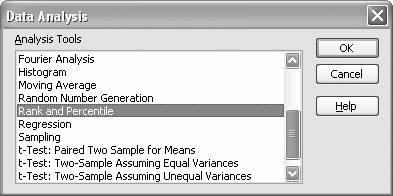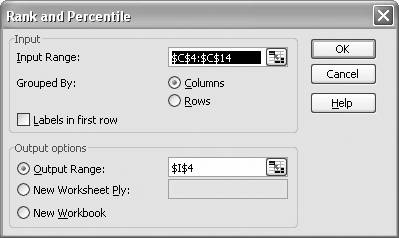Ranking and Percentiles
Problem
You need to compute certain percentiles of a set of data and you'd also like to compute the rank of certain values in the dataset.
Solution
Use the built-in functions PERCENTILE, RANK, and PERCENTRANK. Or you can use the Rank and Percentile tool available in the Analysis ToolPak.
Discussion
By way of example, let's assume your dataset consists of the values 1, 3, 5, 7, 9, 2, 4, 6, 8, 10, and 0. Let's also assume this dataset resides on a spreadsheet in the cell range C18:C28. (This is a rather simple dataset for example purposes; in practice your dataset can be anything and it need not be sorted.)
To compute the 25% percentile, use the formula =PERCENTILE(C18:C28,0.25), which returns a value of 2.5. To compute the 95% percentile, use =PERCENTILE(C18:C28,0.95), which returns a value of 9.5 as expected.
To compute the rank of a given value, use the formula =RANK(2,C18:C28,1). The rank of the value 2 in this dataset is 3, assuming the dataset is sorted in ascending order. If you want to compute the rank of a value as though the dataset were in descending order, then use a value of 0 for the third argument in the call to RANK.
If you'd like to compute the rank of a value in percentage terms, then use the PERCENTRANK function. For example, =PERCENTRANK(C18:C28,2,2) returns the rank of the value 2 as 20%. The second argument in this function call represents the value whose rank is sought. The third argument is the number of significant digits for the result (in this case, two significant digits).
Instead of using these built-in functions, you could use the Analysis ToolPak's Rank and Percentile tool. Select Tools images/U2192.jpg border=0> Data Analysis from the main menu bar to open the Data Analysis dialog box shown in Figure 5-13.
Select "Rank and Percentile" from the list and press OK to open the "Rank and Percentile" dialog box shown in Figure 5-14.
In the Input Range field, type (or select from your spreadsheet) the cell range containing the input dataset you'd like to rank. You can also specify the output location, as shown in Figure 5-14.
Figure 5-13. Data Analysis dialog box

Figure 5-14. Rank and Percentile tool dialog box

For the simple example dataset discussed earlier, the Rank and Percentile tool returns the results shown in Figure 5-15.
The ranks are computed assuming the data is sorted in descending order. The first column in the resulting table contains an index for each data point. The second column contains the raw value of the data point. The third column contains the corresponding rank. The last column contains the percentage rank.
In the event of ties (that is, where two or more values in the dataset are the same), you may want to use the correction recommended in Excel's help file for computing ranks. The formula to use is =[COUNT(data)+1-RANK(value, data, 0)-RANK(value, data, 1)]/2. In this formula, data is a cell reference containing the input dataset and value is the value for which you want to find a rank. See the Excel help topic for the RANK function for more information. To the best of my knowledge, the Rank and Percentile tool in the Analysis ToolPak does not handle ties. So if your data contains ties and you need to correct for this, you should use the RANK function instead.
Figure 5-15. Rank and Percentile results

Using Excel
- Introduction
- Navigating the Interface
- Entering Data
- Setting Cell Data Types
- Selecting More Than a Single Cell
- Entering Formulas
- Exploring the R1C1 Cell Reference Style
- Referring to More Than a Single Cell
- Understanding Operator Precedence
- Using Exponents in Formulas
- Exploring Functions
- Formatting Your Spreadsheets
- Defining Custom Format Styles
- Leveraging Copy, Cut, Paste, and Paste Special
- Using Cell Names (Like Programming Variables)
- Validating Data
- Taking Advantage of Macros
- Adding Comments and Equation Notes
- Getting Help
Getting Acquainted with Visual Basic for Applications
- Introduction
- Navigating the VBA Editor
- Writing Functions and Subroutines
- Working with Data Types
- Defining Variables
- Defining Constants
- Using Arrays
- Commenting Code
- Spanning Long Statements over Multiple Lines
- Using Conditional Statements
- Using Loops
- Debugging VBA Code
- Exploring VBAs Built-in Functions
- Exploring Excel Objects
- Creating Your Own Objects in VBA
- VBA Help
Collecting and Cleaning Up Data
- Introduction
- Importing Data from Text Files
- Importing Data from Delimited Text Files
- Importing Data Using Drag-and-Drop
- Importing Data from Access Databases
- Importing Data from Web Pages
- Parsing Data
- Removing Weird Characters from Imported Text
- Converting Units
- Sorting Data
- Filtering Data
- Looking Up Values in Tables
- Retrieving Data from XML Files
Charting
- Introduction
- Creating Simple Charts
- Exploring Chart Styles
- Formatting Charts
- Customizing Chart Axes
- Setting Log or Semilog Scales
- Using Multiple Axes
- Changing the Type of an Existing Chart
- Combining Chart Types
- Building 3D Surface Plots
- Preparing Contour Plots
- Annotating Charts
- Saving Custom Chart Types
- Copying Charts to Word
- Recipe 4-14. Displaying Error Bars
Statistical Analysis
- Introduction
- Computing Summary Statistics
- Plotting Frequency Distributions
- Calculating Confidence Intervals
- Correlating Data
- Ranking and Percentiles
- Performing Statistical Tests
- Conducting ANOVA
- Generating Random Numbers
- Sampling Data
Time Series Analysis
- Introduction
- Plotting Time Series Data
- Adding Trendlines
- Computing Moving Averages
- Smoothing Data Using Weighted Averages
- Centering Data
- Detrending a Time Series
- Estimating Seasonal Indices
- Deseasonalization of a Time Series
- Forecasting
- Applying Discrete Fourier Transforms
Mathematical Functions
- Introduction
- Using Summation Functions
- Delving into Division
- Mastering Multiplication
- Exploring Exponential and Logarithmic Functions
- Using Trigonometry Functions
- Seeing Signs
- Getting to the Root of Things
- Rounding and Truncating Numbers
- Converting Between Number Systems
- Manipulating Matrices
- Building Support for Vectors
- Using Spreadsheet Functions in VBA Code
- Dealing with Complex Numbers
Curve Fitting and Regression
- Introduction
- Performing Linear Curve Fitting Using Excel Charts
- Constructing Your Own Linear Fit Using Spreadsheet Functions
- Using a Single Spreadsheet Function for Linear Curve Fitting
- Performing Multiple Linear Regression
- Generating Nonlinear Curve Fits Using Excel Charts
- Fitting Nonlinear Curves Using Solver
- Assessing Goodness of Fit
- Computing Confidence Intervals
Solving Equations
- Introduction
- Finding Roots Graphically
- Solving Nonlinear Equations Iteratively
- Automating Tedious Problems with VBA
- Solving Linear Systems
- Tackling Nonlinear Systems of Equations
- Using Classical Methods for Solving Equations
Numerical Integration and Differentiation
- Introduction
- Integrating a Definite Integral
- Implementing the Trapezoidal Rule in VBA
- Computing the Center of an Area Using Numerical Integration
- Calculating the Second Moment of an Area
- Dealing with Double Integrals
- Numerical Differentiation
Solving Ordinary Differential Equations
- Introduction
- Solving First-Order Initial Value Problems
- Applying the Runge-Kutta Method to Second-Order Initial Value Problems
- Tackling Coupled Equations
- Shooting Boundary Value Problems
Solving Partial Differential Equations
- Introduction
- Leveraging Excel to Directly Solve Finite Difference Equations
- Recruiting Solver to Iteratively Solve Finite Difference Equations
- Solving Initial Value Problems
- Using Excel to Help Solve Problems Formulated Using the Finite Element Method
Performing Optimization Analyses in Excel
- Introduction
- Using Excel for Traditional Linear Programming
- Exploring Resource Allocation Optimization Problems
- Getting More Realistic Results with Integer Constraints
- Tackling Troublesome Problems
- Optimizing Engineering Design Problems
- Understanding Solver Reports
- Programming a Genetic Algorithm for Optimization
Introduction to Financial Calculations
- Introduction
- Computing Present Value
- Calculating Future Value
- Figuring Out Required Rate of Return
- Doubling Your Money
- Determining Monthly Payments
- Considering Cash Flow Alternatives
- Achieving a Certain Future Value
- Assessing Net Present Worth
- Estimating Rate of Return
- Solving Inverse Problems
- Figuring a Break-Even Point
Index
EAN: 2147483647
Pages: 206
- Understanding SQL Basics and Creating Database Files
- Using SQL Data Definition Language (DDL) to Create Data Tables and Other Database Objects
- Using Data Control Language (DCL) to Setup Database Security
- Understanding Transaction Isolation Levels and Concurrent Processing
- Repairing and Maintaining MS-SQL Server Database Files
